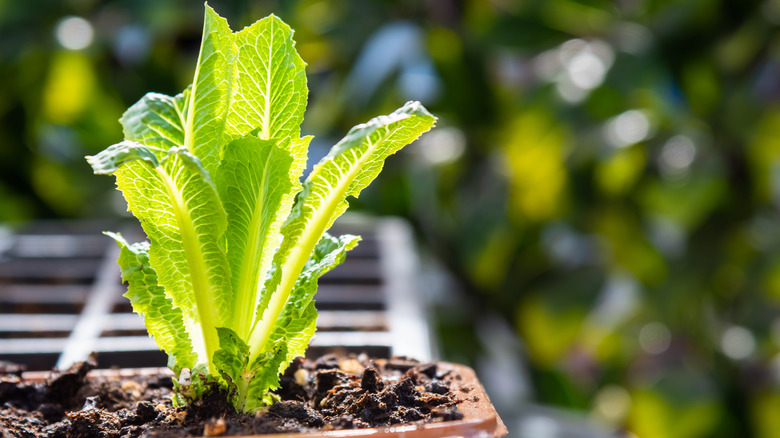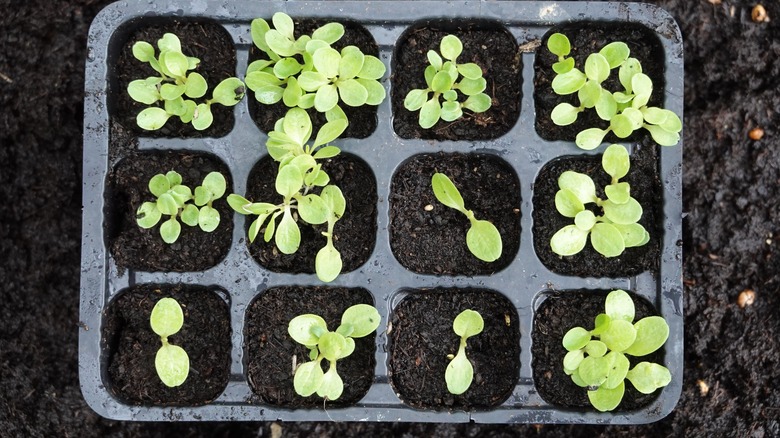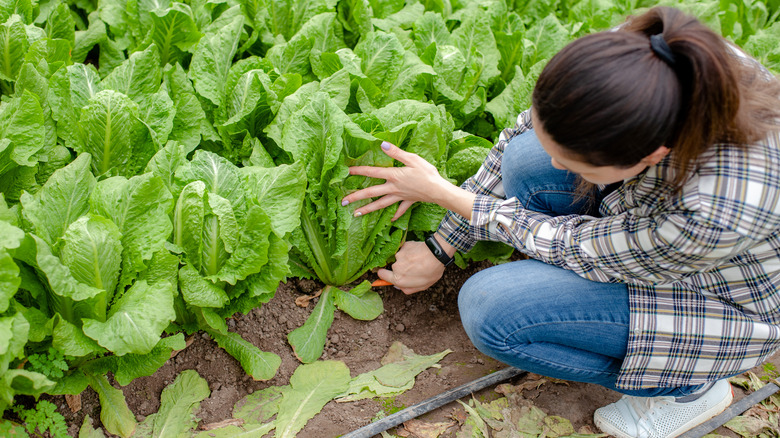How To Start Growing Romaine Lettuce In Your Garden
Want to drift off to Greece without ever leaving your backyard? Growing romaine lettuce is your one-way ticket there. Originating from the Mediterranean, this leafy green, characterized by its narrow stalk and vertical ribs, is easy to grow from seed or even a transplant. Like you would with any other plant, start growing romaine lettuce by clearing your soil of any rocks or weeds, and smooth the surface so that it's level.
You can plant the seeds directly in the ground, known as direct seeding. However, if you live in a colder climate, you want to be mindful of your first and last frost dates so you don't plant seeds when they're still vulnerable to low temperatures. Optimum soil temperatures for lettuce is 45 to 65 degrees Fahrenheit. In this case, you can opt to sow seeds in a starter tray that remains indoors until warmer weather approaches.
Not only does romaine lettuce need five to six hours of sun exposure when it matures, but seeds need light to germinate. As such, it's best to plant the seeds in a sunny location and avoid planting below ½ inch deep. For best results, plant between ⅛ and ¼ inch deep. Additionally, space planting rows 12 to 15 inches apart. Then, gently water the seeds and expect your romaine lettuce to germinate in seven to 10 days.
Caring for romaine lettuce seedlings
Once your lettuce seeds sprout, it's time to thin them out. Thinning is a process of deliberately removing seedlings from a given area. This helps to manage overcrowding so the remaining sprouts can grow more robustly. With sharp scissors, cut off weak seedlings at the base of the stem. The goal is to have one to two healthy seedlings remaining per planting hole. If you don't thin seedlings, your lettuce may be prone to developing fungal disease from a lack of air circulation and, ultimately, won't be as healthy as possible because they are also competing for root space, light, and nutrients.
After thinning the seedlings, maintaining the health of your new lettuce sprouts is rather simple. The soil should be evenly moist and watered every other day or whenever the surface of the soil is dry to the touch. Additionally, monitor outdoor-grown seedlings for sunburn. Sunburn happens to seedlings when the sunlight is too harsh and scorches the leaves, causing them to brown and in some cases die. If this occurs, it may be helpful to DIY a sun shade for your seedlings.
Meanwhile, if you choose to start seeds indoors, controlling the elements is easier. You can expose seedlings gradually to the outdoors by leaving them outside in shade for one hour and increase light exposure from there until they are strong enough to be transplanted into a garden bed, which shouldn't be long. Lettuce seedlings are hardy enough to be transplanted as soon as the soil temperature is favorable.
Tips for harvesting your romaine lettuce
Your romaine lettuce may be ready for harvest approximately 65 to 70 days after seed germination, but paying close attention to the appearance of the lettuce is key. The lettuce is ready for picking when the ribs are dense but not so thick that the leaves are tough. Harvesting at optimal times won't leave you wondering why your home-grown lettuce tastes bitter. The head of the lettuce will open slightly, almost similar to a flower in bloom.
The leaves will be dark green and typically 12 inches tall, depending on the variety of romaine lettuce you planted. If you prefer to have an ongoing harvest throughout the season, one of the best ways to harvest your lettuce is to remove the outer leaves of the head. These leaves are the most mature and, by only removing the oldest leaves when harvesting, you allow the lettuce plant to continue to grow and produce longer.
However, if you'd like to harvest your plant once and be done with it, you can gather the lettuce head in your hand and, while firmly holding the head, use a pair of garden shears to cut the lettuce plant at its base. This will remove the lettuce head completely. Whichever method you choose, rest assured that you will have a crunchy salad ready to go in no time.


